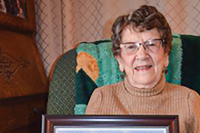Different tribes treated captives differently
I conduct workshops on Southeastern Indian history and culture at the John C. Campbell Folk School for two full weeks a year and for various Elderhostels throughout the year. One topic that surfaces quite often is the manner in which these Indians treated enemies captured in warfare or by chance. The answer is, “It all depends.”
Not infrequently, other Indians were adopted and treated as kinsmen. Some were enslaved in the sense that he belonged to the man who captured him in war. He became part of that person’s household and performed menial duties. In The Southeastern Indians (University of Tennessee Press, 1976), University of Georgia anthropologist Charles Hudson describes captives of this sort as “a sort of living scalp;” that is, he enhanced the prestige of the captor. Still other captives were executed brutally or tortured to death.
A common method of torture was used throughout North America — the ritual burning of the captive at a stake in the middle of the village. The Natchez tribe, situated in what is now southeastern Mississippi, elevated torture to another level, as described by Dr. Hudson:
“When the Natchez decided to torture a captive to death, they first constructed a framework made of two poles about 10 feet long, set into the earth about five feet apart. A crosspiece was then tied between the poles about two feet above the ground and another crosspiece was tied about five feet above this, forming a square frame. The victim was tied to the foot of the frame and was fed his last meal. Everyone then assembled and the man who captured the victim uttered a death cry and struck him at the base of his neck with a war club, knocking him unconscious. He was then scalped and tied to the frame, with his wrists and ankles at the four corners of the frame, forming an X. His scalp was taken to relatives of slain Natchez, and they used it to ‘wipe tears from their eyes.’ (The now-conscious captive) was then tortured with torches of burning cane applied to various parts of his body, all this being done in the spirit of revenge. Throughout it the victim was expected to sing a death song. Sometimes the torture lasted for several days.”
After European contact, French, British, and Spanish captives were subject to the same possibilities. One of the more interesting “captive stories” in Cherokee history is that of a certain Antoine Bonnefoy, about whom little or nothing is known except what is revealed in the so-called “Journal of Bonnefoy.” This account was recorded in 1742 by a French Captain, Monsieur Derneville, at a French outpost where Bonnefoy found refuge after escaping from the Cherokees at Tellico on the lower Little Tennesse River in present-day Tennessee. The manuscript eventually found its way to the Archives Nationales in Paris, where it was translated by Dr. J. Franklin Jameson into English and published in 1916 in David Mereness’ collection titled Travels in the American Colonies. Jameson’s translation was subsequently annotated by Samuel Cole Williams and published again in Early Travels in the Tennessee Country: 1540-1800 (Watauga Press, 1928). The Williams edition is quoted here. Material in parentheses is added by this writer for clarity:
“The savages directed so heavy a fire upon our boat that we were obliged to lie down flat, to escape certain death. Immediately, 20 of these savages got into their boats to hasten after the pirogue of Sieur Marin, who escaped from them. A moment afterward, these same pirogues came and surrounded us. The shore was lined with other savages, who were aiming at us. The surprise, and the death of our skipper and two of our oarsmen, having put us out of condition to defend ourselves, we surrendered .... The savages who had taken possession of us proved to be Cherakis (Cherokees), instead of Chicachas (Chickasaws) as we had thought at the time of firing .... They passed the day in packing their (stolen) merchandise, till night, when they embarked in 22 boats, with two, three, four, or five men in each according to its size.”
Related Items
The incredibly long journey from the Mississippi back up the Ohio and the Tennessee rivers to Cherokee lands in present-day eastern Tennessee was not completed until late January. The last overland leg was completed on Feb. 3, when the Cherokees warriors and their captives arrived in “Talekoa” (Tellico).
“(Having) left us nothing but breeches, (we) made the entry into their village in the order of a troop of infantry, marching four in each rank, half of them in front of us, who were placed two and two after being tied together, and having our collars dragging .... They made us march in this order, singing, and having ... a white stick and a rattle in our hands, to the chief square of the village and march three or four times around a great tree which is in the middle of that place. Then they buried at the foot of the tree a parcel of hair from each one of us, which the savages had preserved for that purpose from the time when they cut our hair off. After this march was finished they brought us into the council-house, where we were each obliged to sing four songs. Then the savages who had adopted us came and took away our collars. I followed my adopted brother who, on entering into his cabin, washed me, then after he told me that the way was free before me, I ate with him, and there I remained two months, dressed and treated like himself ... The 29th of April, a day on which the savages had given themselves up for a debauch, was that we chose for our escape.”
Eventually separated from his companions for good during the escape, Bonnefoy made his way overland in a harrowing journey, during which he fasted for five days and was captured yet again (apparently by Creek Indians in present-day Alabama). He eventually make his way back to French-controlled lands, apparently at present-day Mobile.
Such were the uncertainties of life on the Southeastern Indian frontier during the 18th century.
Editor’s note: This column by George Ellison first appeared in The Smoky Mountain News in 2002.
George Ellison wrote the biographical introductions for the reissues of two Appalachian classics: Horace Kephart’s Our Southern Highlanders and James Mooney’s History, Myths, and Sacred Formulas of the Cherokees. In June 2005, a selection of his Back Then columns was published by The History Press in Charleston as Mountain Passages: Natural and Cultural History of Western North Carolina and the Great Smoky Mountains. Readers can contact him at P.O. Box 1262, Bryson City, N.C., 28713, or at This email address is being protected from spambots. You need JavaScript enabled to view it..









